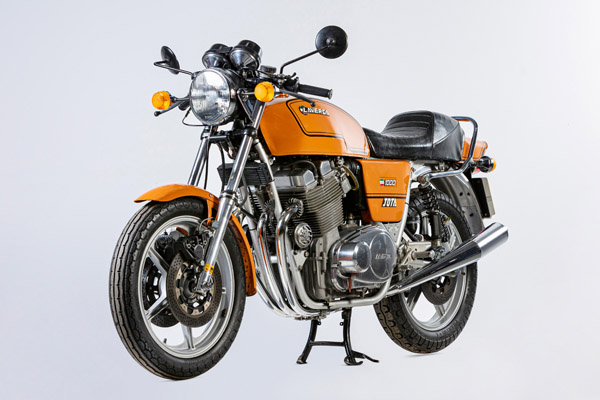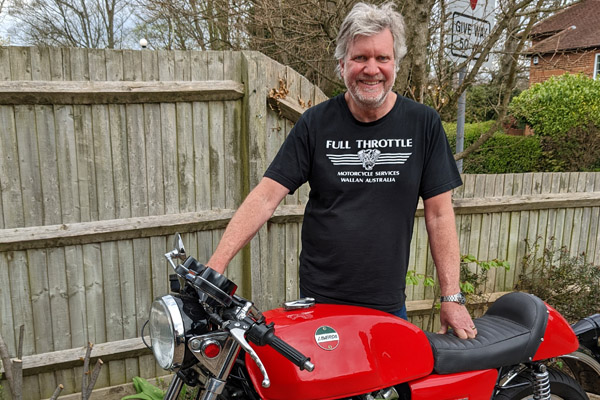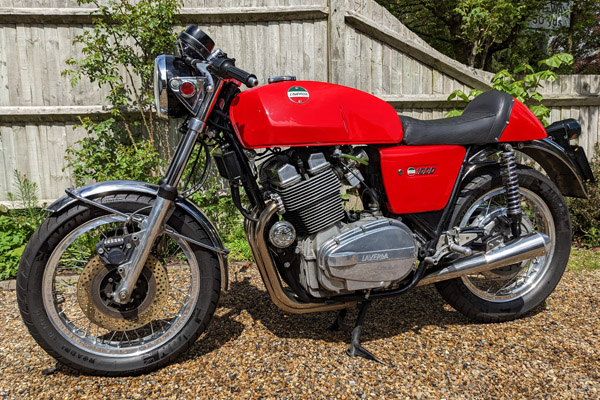23 April 2025
It's not just the brochure, showroom or road test that swings your thoughts towards acquiring a bike - sometimes it's the perfect storm of circumstances and where you just happen to be at that moment. Iain Macauley, automotive journalist, explores the topic further.
My moment was on holiday in Rome. Between the high-pitched sounds of two-stroke scooters, the hum of cars and the clacketing of busses and trucks I sensed a different note: an offbeat thrum that could only be a three-cylinder motorcycle engine.
Something in my subconscious said a three-cylinder thrum was unusual in Italy, and scanning the traffic I tracked the sound, and spotted some corresponding movement.

Photography courtesy of "Bonhams Cars"
And then the traffic thinned out, and sound and vision both came into focus. A super-cool looking guy, jeans, leather jacket, Ray Bans and equally noticeable female pillion passenger.... on a Laverda Jota.
The low bars somehow added to the aura - like a '70s 500cc Grand Prix race winner, helmet off, nonchalantly trundling down the pit lane.
The vision supplemented a minds-eye image that had been stuck in my mind for decades: when the top speed of a motorcycle makes the front page headline of a bike magazine or paper, you know it's significant.
I can't remember precisely where or when, but I can recall the headline itself.
It simply read "140mph!"
In that Rome moment I'd have bought that Laverda on the spot. My mental definition of "cool" had just been indelibly etched in my mind.
The 140mph headline bike was a Laverda Jota, and back in 1975 it was topping out at around 10mph faster than the Japanese superbikes of the moment.
But it wasn't a v-max that was down to wizardry in the Briganze, Italy, Laverda factory. In fact, the Jota didn't initially exist as a factory bike. It started life as the "3C" as in three-cylinder. It was, actually down to the recognition by the UK importers - Slater Bros - that the 85bhp pumped out by the 981cc Laverda triple was short of its true potential.
Slater Bros tinkered with the motor's innards, developed and fitted more efficient exhausts, and created the 3CE ("E" for England), the spec being adopted by the factory who named the bike the "Jota", after the name of an uneven beat of a dance - the distinctive uneven beat of the Laverda triple being its signature soundtrack.
Mark Hunt is a committee member of the International Laverda Owners Club.

"At the time, not many Italian manufacturers built big bikes, so Laverdas stood out. To us owners, they've always been cool - and thre Jota had a halo effect. Whenever i stop those in the know will come up and ask whether my bike is a Jota.
"Mine's a '74 3C, so that's a 1000 that looks exactly like the bike the Jota was based on. Slater Brothers famously put a set of hot cams and some decent exhausts on it - and the thing went like a rocket; they sort of de-restricted it if you like," he said.

"But the standard 3C is still a lovely bike. So very torquey. It's big for a European bike, but handles really well."
The Jota wasn't all about straight line speed, it was also a great handler - being a multiple British Production Motorcycle Championship series winner.
"They're amazingly robust, built to last. The motors do big miles - 40,000 to 60,000 miles no problem. That's part of their charm: longevity - they're not fragile. Of course it's a 50 year old motorcycle so it needs maintenance and needs looking after.
"And we need to source parts obviously, something else the owners club tries to help with as, not everything is available now. There's a community that helps support things like getting gasket sets made, cables, clutch plates and all that sort of stuff."
A spokesperson for Bonhams, the auctioneers, commented on a Jota which recently sold for £23,000:
"The production Jota was more highly-tuned, its 140mph top speed making it the world's fastest road-going production motorcycle at the time of its launch . It was also pretty handy on the racetrack, winning the UK's Avon championship in 1976 and 1978 in the hands of Pete Davies.
"Few major changes were made to the Jota prior to 1982 when a heavily revised version was introduced, complete with a 120-degree crankshaft that made for a more even firing order than the original's 180-degree 'flat' crank.
"Today, the Jota is one of the most collectible of Italian classics, particularly the first '180' version."

COMMENT